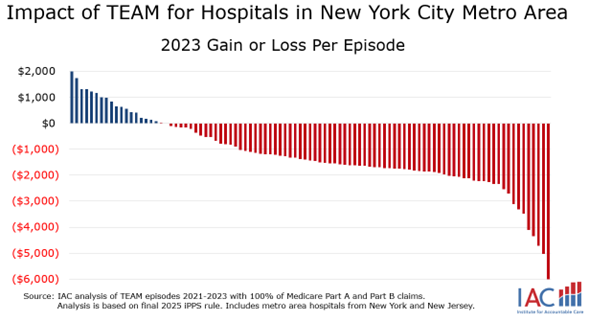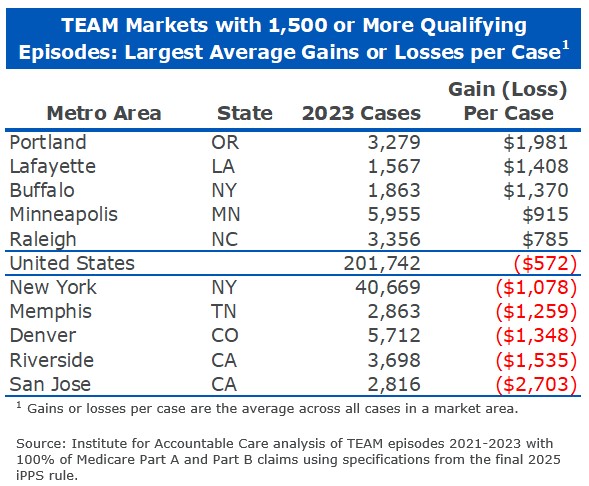Performance in CMS’s TEAM Model? It Will Depend on Where You Are, And Who You Are
CMS announced its latest push towards value-based care in the spring with the Transforming Episode Accountability Model (TEAM). TEAM is a bundled payment program focused on five surgical episodes of care and is mandatory in selected markets.
Now that the 2025 IPPS final rule is in place, we can start to assess the impact of TEAM by selected area and by hospital. As part of a collaborative effort, the Institute for Accountable Care (IAC) has modeled target prices under TEAM using the full Medicare claims database. Pairing this with 2023 costs and volumes it is possible to estimate the impact of TEAM for each mandatory market and for every hospital required to participate. Importantly, episode target prices are based on average risk-adjusted spending for each of nine census regions. The initial financial impact of TEAM is baked in at the start, creating either a financial headwind or tailwind before hospitals take any steps to improve their performance.
The table below shows those mid-sized to large markets that will be most heavily impacted by TEAM – either positively or negatively.
On average across the US there is a loss of about $570 per case for those markets selected for TEAM. Drilling down by market, though, reveals that TEAM plays out quite differently across the country, with some areas getting a significant tailwind to do well in TEAM, and other areas facing a significant headwind – losses per case – unless they act.
But metro area average results are not what matter to hospital leaders. What matters is how their particular hospital will fare under TEAM. And again, the range is staggering. The NYC Metro area stands to lose about $1,078 per case on average, but, as shown in the chart below, individual hospital results range from a $2,000 gain per episode to a loss of $6,000 per episode.
 Knowing where your hospital sits is important to deciding how to prepare for TEAM.
Knowing where your hospital sits is important to deciding how to prepare for TEAM.
Performance was assumed to remain stable in these figures – but it doesn’t have to. These gains and losses represent the baked-in impact from the TEAM pricing model. However, whether you have a tailwind or headwind, the real opportunity is to improve performance for financial and clinical quality gains.
More on that opportunity in our next blog in this TEAM series.
Contact the Authors:
John Harris, Managing Director, jharris@veralon.com
Molly Johnson, Consultant, mjohnson@veralon.com
